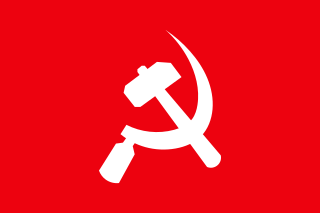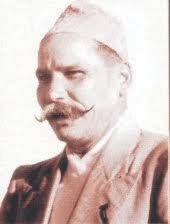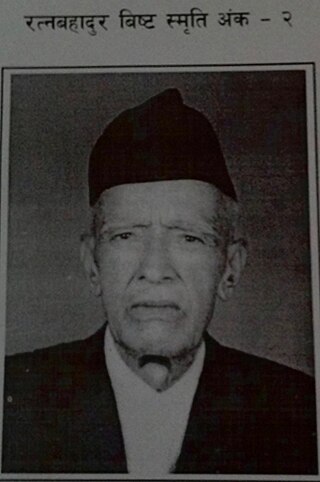
The Communist Party of Nepal, abbreviated CPN, was a communist party in Nepal from 1949 to 1962. It was founded on 15 September 1949 to struggle against the autocratic Rana regime, feudalism, and imperialism. The founding general secretary was Pushpa Lal Shrestha. The founding members of the Communist Party of Nepal were Moti Devi Shrestha, Niranjan Govinda Vaidya, Nar Bahadur Karmacharya and Narayan Bilas Joshi.
Samyukta Prajatantra PartyNepal was a political party in Nepal. The party was led by Kunwar Inderjit Singh.

Kunwar Indrajit Singh, popularly known as Dr. K.I. Singh or just K.I. Singh was a Nepali politician and revolutionary who served as the 20th Prime Minister of Nepal in 1957. He was a key member of the Nepali Congress for his role in organizing the 1951 Nepali Revolution, and was a leader in its militant wing, the Muktisena, and later refused to recognize the Delhi Accord and was forced to flee the country following a revolt he took part in. In 1955 he returned and formed the United Democratic Party, and following the installation of the Panchayat system he fought for its end, for which he was jailed. Following his release, he went into self-imposed exile, but eventually returned to Nepal and was elected a member to the Rastriya Panchayat. He became known as the "Robin Hood of the Himalayas", becoming an incredibly popular figure throughout the country.

Following the Nepalese Constituent Assembly Election on 10 April 2008, the Communist Party of Nepal formed a government out of the 1st Nepalese Constituent Assembly led by Pushpa Kamal Dahal and backed by the Communist Party of Nepal , Madhesi Jana Adhikar Forum, Nepal, Sadbhavana Party, Janamorcha Nepal and the Communist Party of Nepal (United).

Ratna Bahadur Bista (1910–1990) was the fifth Chief Justice of Nepal. He was born in Dadeldhura to an aristocratic family that was given land grants in Sudurpashchim Province circa 1911 during a hunting trip by King George V of the United Kingdom and Chandra Shumsher Jang Bahadur Rana, the Prime Minister of the Rana Dynasty. He went on to become the 5th Chief Justice of Nepal, in office from 26 July 1970 to 6 August 1976. He was appointed by the then-king of Nepal, Mahendra. He was responsible for the Summary Procedure Act 1971. The Committee that he established recommended for the establishment of High Courts in different regions which resulted in the creation of a four tiered judicial structure with one additional tier in the middle- "the Regional Courts."

Zamindar Sir Lok Pratap Bista , was appointed by late King Mahendra of Nepal as the minister of Forest and Environment under the government led by Prime minister Surya Bahadur Thapa. The decree for forest conservation was released under his tenure that made logging illegal which was signed by King Mahendra of Nepal on October 5, 1970. He is responsible for setting up the Shuklaphanta National Park and Bardiya National Park as a Wildlife Reserve in 1969 under his tenure as Minister of Forests from 1968 to 1972. When the Democratic Government was dissolved by King Mahendra, he was nominated to the National Panchayat and made a Minister of Forests and Environment in 1968. He is the nephew of the late Chief Justice Ratna Bahadur Bista. During his tenure as the Minister of Forestry in FY 1970 the National GDP was estimated at $840 million in which Agriculture and forestry accounted for two- thirds of GDP. There was a 7.5% increase in GDP from FY 1969 since he took office.
Amik Sherchan is a Nepalese politician and current Governor of Lumbini Province of Nepal. He is former chairman of Janamorcha Nepal. He served as the Deputy Prime Minister & Health and Population Minister of Nepal in the interim government under Girija Prasad Koirala cabinet. He also served as the 2nd Governor of Gandaki Province of Nepal. He is active as a politician and prominent leader since 1967. He was elected as a member of the Pratinidhi Sabha and Member of 1st Constituent Assembly from Chitwan.

Matrika Prasad Koirala formed the first government of Nepal by a commoner after he was appointed as the prime minister by King Tribhuvan. The government was formed after the previous government under Mohan SJB Rana fell after Nepali Congress ministers resigned. King Tribhuvan made a royal proclamation on 16 November 1951 and invited Matrika Prasad Koirala from the Nepali Congress to form the government.

Matrika Prasad Koirala formed his second government in 1953 after his appointment by King Tribhuvan. The cabinet was expanded in February 1954 to include Nepal National Congress, Nepal Praja Parishad and Nepali Jan Congress.

Kunwar Inderjit Singh formed a government on 26 July 1957 after being appointed by King Mahendra. He replaced Tanka Prasad Acharya who had resigned on the same day.

Bisheshwar Prasad Koirala formed the first elected government of Nepal on 27 May 1959. After the 1951 democratic movement, several transitional governments failed to hold the first general elections in the country until an interim government under Subarna SJB Rana held the 1959 general elections in two phases on 18 February and 3 April 1959. Nepali Congress gained a majority in the 1st House of Representatives of Nepal and Bishweshwar Prasad Koirala was elected as the parliamentary party leader of the Nepali Congress on 4 May 1959. On 16 May 1959, Koirala was invited by King Mahendra to form a government and the cabinet was formed on 27 May 1959. The cabinet was reshuffled just over a month later on 30 June 1959.

Parashuram Khapung (Limbu) is a Nepalese politician and current Governor of Koshi Province. He was appointed Governor, as per the Article 163 (2) of the Constitution of Nepal by the President Bidya Devi Bhandari on the recommendation of the Council of Ministers of the Government of Nepal on 11 November 2021. He is a former member of House of representatives.
Dhanraj Gurung is a Nepali politician belonging to Nepali Congress. Gurung is the current Minister for Law, Justice and Parliamentary Affairs of Nepal. He is the current member of House of Representatives having been elected from Syangja 2.
Krishna Prasad Sitaula is a Nepali politician, belonging to the Nepali Congress. He who is the leader of Nepali Congress parliamentary party in upper house, Rastriya Sabha. Sitaula is known for playing an important role during the comprehensive peace accord.
Kalpana Bista was the first female minister of education of Nepal in 1978.










